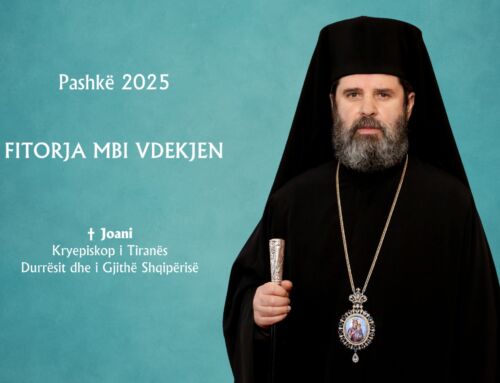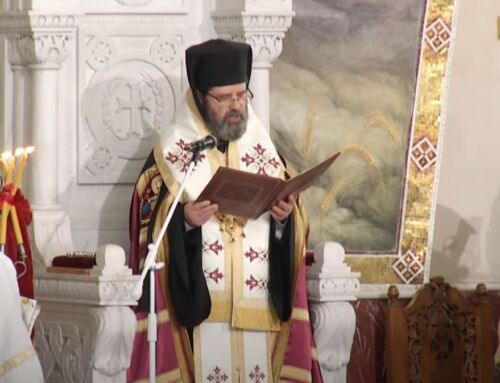Towards the Holy and Great Synod of the Orthodox Churches*
I am pleased to inform you about an important issue. This year, the Holy and Great Synod of the Orthodox Churches will meet during the week of Pentecost, and such an event has been long awaited for. To better understand the present occurrences and the importance of the decision for the meeting of the Holy and Great Synod, I will start with a summary of the Church history in the first two millennia:
1. In the first millennium, after gaining the freedom of religious conscience and the issuance of the Edict of Milan by Constantine the Great and Licinius, five main ecclesiastical centers were created which were Rome, Constantinople or the New Rome, Jerusalem, Alexandria and Antioch. With the development of Christianity various problems arose in the local churches. Several threats of heresy and divisions came up. To solve out such problems the Councils of Orthodox Bishops were called. Some of the issues were local, but the most serious issues, especially those dogmatic in character were dealt with by the Ecumenical Councils. The emperor would gather the Ecumenical Synod but the head of the Synod was always a well- known Patriarch. Thus the seven Ecumenical Councils of the undivided Church of the first millennium were gathered.
At the beginning of the second millennium, the scary trial of schism occurred between the West and the East (1054), which was an event that created conflicts and delays in the spread of Christianity. In addition, two administrative poles were created. Rome was in the west. But after the Renaissance era (half of the 15th century), different protesting movements appeared against the Church of Rome and gradually the Protestant churches got established. In the East, the four early patriarchates (Constantinople or the New Rome, Alexandria, Antioch and Jerusalem) stayed united. Great trials resulted due to invasions by Muslim populations. But at the same time, great development of Orthodoxy was achieved in the North such as the Christianization of the Slavic tribes, mainly in Russia. This endeavor began in the late first millennium. The Russian people as a single body accepted Orthodox faith and churches there continued the Byzantine missionary work in North Asia. Thus a new church center was created, which was the Moscow Patriarchate.
By the middle of the fifteenth century until the mid-nineteenth, the Orthodox peoples of the Balkan Peninsula and Asia Minor lived under the Ottoman Empire. After the gradual liberation of the peoples of the Balkans, the Ecumenical Patriarchate gave the autocephaly to the Church of Greece, Serbia, Romania and Bulgaria. In the twentieth century, it gave the autocephaly to the Churches of Poland, Albania, the Czech Lands and Slovakia, whereas the Georgian Church was recognized as a Patriarchate. The Church of Cyprus gained its autocephaly after the decision of the Ecumenical Synod.
Nowadays, the actual state of the Orthodox Church is as follows: There are the early patriarchates of Constantinople, Alexandria, Antioch and Jerusalem, the later patriarchates of Russia, Serbia, Romania, Bulgaria, Georgia as well as the Autocephalous Churches of Cyprus, Greece, Poland, Albania, Czech-Slovakia. It is a total of 14 Autocephalous Orthodox Churches. The Holy, Catholic and Apostolic Church of the East maintained its unity, its common sacramental life, especially the Divine Eucharist, the apostolic succession of its bishops and kept unchanged the sources of faith, that is the Holy Scripture, the Holy Tradition as well as the Apostolic Canons of the Synods. The coordination center of the Orthodox Churches is still the Ecumenical Patriarchate of Constantinople.
2. After World War II, various Autocephalous Orthodox Churches faced a series of persecutions by the atheist communist governments which took power in their countries until their fall. After the Second World War with the beginning of the Christian ecumenical movement, we, the Orthodox, had the occasion to organize various meetings with other Christians in several gatherings and conferences, and the common desire to assemble in a Holy and Great Synod of the Orthodox strengthened even more.
In 1960, in Rhodes, the first preparations for the Holy and the Great Synod started and the main topics for discussion were decided. Later it was agreed to build up several pan-orthodox commissions which would deal with the issues at stake and formulate the pre-Synodic texts. Over time, various problems arouse and delays in time led to skepticism, ironic comments and doubts whether the Synod of the Orthodox Churches would ever get realized. Fortunately, a very important event took place. Several meetings of the Heads of the Orthodox Churches were held in Constantinople in 1993, then in Jerusalem in 2000, in Constantinople, 2008, 2014. Particularly important were the meetings of 2008 & 2014 and the messages which were delivered in them.
In the Meeting of 2014, they decided for the Holy and Great Synod to meet in Constantinople and more specifically, in the Church of St. Irini, if nothing unexpected occurred. Also they set the rule that every Autocephalous Orthodox Church must be represented by 24 bishops and have the right of one vote. Eventually, the unexpected happened: the tension of relations between Turkey and Russia due to the Russian military plane crash. After this event, two options were left: either to put off the Holy and Great Synod, or to gather in another country.
Finally, during the last meeting of the Heads of Churches in Chambesy, Geneva, Switzerland (22 to 28 January 2016), it was finally decided that the Holy and Great Synod be held during the Pentecost week (19 to 26 June 2016), in Crete (Orthodox Academy of Crete, Kolymbari). The Church of Crete is apostolic, autonomous and it is under the Ecumenical Patriarchate; it is part of the European Union and provides all the necessary conditions for the peaceful development of the Holy and Great Synod.
The above decisions were not easy to make. Strong prayers were needed as well as flexibility of thought, opportunities for the formulation of ideas, and persistent efforts to convince those who had opposing ideas or plans. Glory to God, the decision was finally made. It is necessary that all of us, clergy and laity pray deeply for the pre-preparation and well-going of the Synod. The Holy and Great Synod will be a blessing to the whole Orthodox Church and to the Christian world in general. And by being a blessing to the Christian world, it will serve as an important step in the progress of the world.
(*) Recorded speech held at the Cathedral “Resurrection of Christ” in Tirana on Sunday, 31 January 2016





